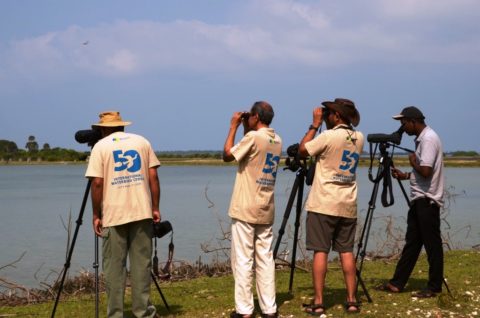
Rising global temperatures driving birds from the tropics faster and at greater scale than anticipated
-
International Waterbird Census
Researchers have discovered that waterbirds around the equator are sensitive to global warming and are reacting more quickly than birds from regions with a more moderate climate.
This is partly because in the hottest regions they are already at the maximum temperature threshold, so even a small increase is fatal. In less heat-intense regions, the range at which the birds can survive is greater.
Higher temperatures are being recorded all around the world in the last years and impacts on thawing of arctic permafrost, melting of the polar icecaps, increased frequencies of forest fires and crippling droughts is now better known. What appears to be less well understood is the impact of these higher temperatures are having at species living in warm climes, such as the tropics, and which hold the highest biodiversity.
Populations of waterbirds decreasing at lower latitudes
An international team of researchers from Universities of Bath, Cambridge, Debrecen and Santa Clara, the National Audubon Society and Wetlands International and the University of Queensland (UQ) in Australia have found that with rising global temperatures, populations of waterbirds were found to decrease at lower latitudes (closer to the equator), while they increased at higher latitudes. The movement from the equator is in the direction of both poles.
The research team reviewed more than 1.3 million records collected since 1990 from 390 species of waterbirds at 6,822 sites in a wide range from the equator. The data was collected by thousands of volunteer counters through the International Waterbird Census co-ordinated by Wetlands International and Christmas Bird Count managed by the National Audubon Society. The birds studied included a wide range of ducks and geese, shorebirds, pelicans, flamingo, herons, storks, ibises, cormorants and cranes.
UQ ARC Future Fellow Dr Tatsuya Amano, who led the research said: “Earlier global reviews of species’ responses to climate change have rarely included species and studies in the tropics – being largely conducted in Europe, North America, Australia and the Arctic. As a result – although tropical species have long been predicted to be more vulnerable to increasing temperature – there was little empirical evidence on how climate change really affects species abundance in the tropics. But, from our research, this is overwhelmingly clear – 69 per cent of the tropical species show negative responses to temperature increases.”

An invaluable dataset
The global dataset of waterbird abundance is the fruit of invaluable, long-term survey efforts in over 100 countries by a large volunteer network and covers regions for which there is little information on climate change impacts. Waterbirds can be observed and monitored relatively easily, offering an early proxy for climate change impacts on other species. They help in assessing the status of biodiversity in wetland ecosystems, which has been lost at higher rates than other ecosystems.
Dr Taej Mundkur, Coordinator of the International Waterbird Census at Wetlands International, who was part of the research team, hopes that this fresh evidence will help strengthen the case for real action on a warming climate. He said: “Many of these waterbird species move around locally while others are migratory and annually move between countries and continents. Thus these large species shifts and loss can have serious consequences, not only for local biodiversity, but also on the ecology and productivity of the coastal and inland wetlands they utilise and for human well-being across the world”.
“This research helps fill in the gaps a little, but it would be great to see it receive even more research attention, especially in the tropics. This would provide crucial evidence for a more effective allocation of limited resources for the conservation of species and ecosystems most threatened by climate change, and for assessing how climate-driven changes in biodiversity may affect human societies,” Dr. Mundkur added.

Translating ecological requirements into national policies and landscape plans
The study confirms the predictions of earlier research led by Wetlands International with BirdLife International and the Universities of Kassel, McGill, Lausanne and Wisconsin, that waterbird species breeding in Africa and the Middle East will suffer major losses of suitable wetland habitat across their ranges and would be adversely affected by climate change. In practice, this means that we need to better integrate our understanding of ecological requirements of waterbirds into national policies and landscape scale plans for land use and water management.
The research was published in the scientific journal Nature Climate Change, which can be found here.
Lead image by Taej Mundkur
